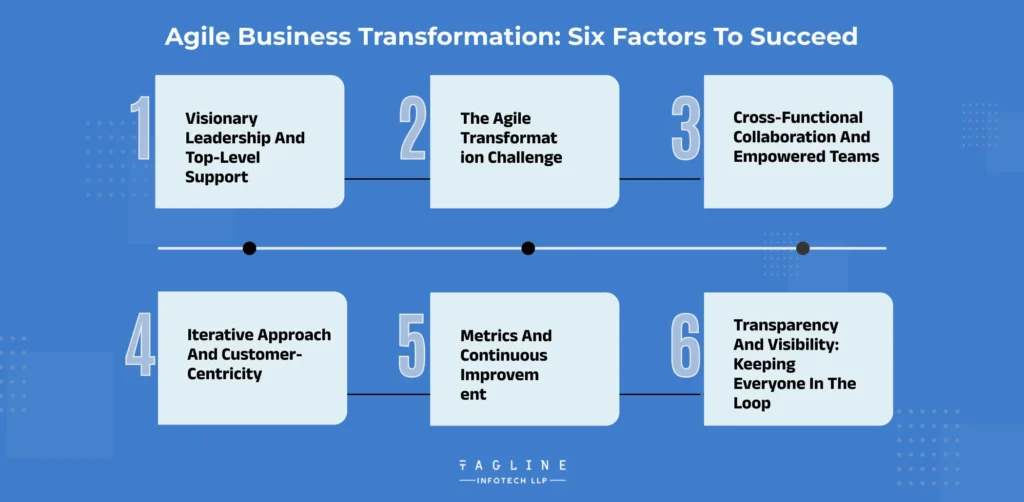Cost-Effective Strategies for Hiring Python Developers
February 17, 2025
Home >> Software >> Agile Transformation: Top 6 Pillars for Success

Quick Summary
Agile is a strategy methodology that has become known for its ability to successfully embrace and manage change inside an organisation. It acts as a stimulant for increased customer attention, corporate resilience, agility, and flexibility. By embracing agile ideas and practices, organisations may maintain their competitiveness in the rapidly evolving business environment. The purpose of this post is to discuss the essential elements of an effective agile transformation that will assist your business in converting challenges into opportunities.
When a company completely adopts an Agile methodology, this is known as agile transformation. This shift isn’t only for the product development team; for an organisation to be fully Agile, all staff members in every division must adhere to the ideals and guidelines stated in the Agile Manifesto. This entails a readiness to cooperate well, speak honestly, and be more adaptable and reactive, aligning with the agile pillars that support collaboration and responsiveness across the organization.
Maximize Business Benefits of Agile Software Development with McKinsey & Company’s holistic approach. A thorough Agile transformation would address the four essential aspects of the organisation: people, processes, technology, and structure, according to managing consulting company McKinsey & Company. Additionally, it will guarantee that the business takes an iterative approach to development, in which tasks are repeated in cycles until the ideal outcome is attained.
Agile business transformation is a tried-and-true approach used by companies to react more quickly, intelligently, and effectively to the ever-changing requirements of their customers. It calls for a complete mentality change that enables businesses to “adapt” to the shifting dynamics of the market in order to stay relevant, endure, and ideally prosper. Agile teams that function well have supportive leadership, a collaborative work environment, people-centric values, and improved alignment with business requirements.

Implementing agile methods successfully begins at the top. Setting the tone, motivating teams, and coordinating company objectives with an agile mentality all depend on visionary leadership. According to 51% of senior executives, one of the main causes of the rise in an organization’s degree of agility during the last five years is the “leadership mandate.” Therefore, appropriate efforts and commitment from top-level leadership are required for the transition or transformation to agile. The senior executive executives must demand a change in perspective and steer the process.
Agile transformation is the process of introducing and putting into practice agile methods and concepts in an organisation to enhance responsiveness, flexibility, and teamwork. Although many sectors have found success with agile approaches, the process of transformation can present a number of difficulties.
Cross-functional cooperation takes precedence over silos in an agile organisation. Businesses that switch to agile from traditionally structured business units provide their people greater autonomy and create more opportunities for innovation and teamwork.
Ready to transform your business with Agile methodologies?
Connect with us to embark on a journey of success. Let’s transform together!
By emphasising an iterative approach to software development, agile digital transformation enables businesses to provide value often and early on. Teams using an agile framework give priority to short-term objectives linked to the delivery of software products and place an emphasis on the product’s quality. The agile methodology gives development teams throughout the company the ability to act quickly and wisely, enabling them to offer the appropriate value at the right moment.
In addition, a successful agile transition depends on attending to client demands and feedback. Organisations may create goods and services that exactly meet end-user expectations by including customer-centricity into the development process.
It is essential to track the development and results of an agile transformation in order to evaluate the success of the adopted practices and pinpoint areas in need of development. To measure the effectiveness of agile projects, businesses need to set up pertinent criteria including time-to-market, customer happiness, and team productivity. Teams may achieve faster top-line development with significant ROI by continuously refining their processes and making well-informed decisions with the support of data-driven insights.
A fundamental tenet of agile project management is transparency. It guarantees that every member of the team and every stakeholder is aware of the status of the project, any obstacles that may arise, and the duties that are ahead of them.
Agile emphasises the value of visualising work and emphasises the use of tools like burndown charts and Agile boards to improve transparency. When everyone is in agreement, it’s simpler to see problems, recognise accomplishments, and make wise choices that will keep the project moving forward.
Agile transformation is not merely a shift in processes; it’s a holistic change encompassing people, processes, technology, and structure. To thrive in today’s rapidly evolving business environment, organizations must adopt Agile methodologies, emphasizing collaboration, iterative development, and customer-centricity. Visionary leadership, cross-functional collaboration, iterative approaches, and continuous improvement through metrics are crucial pillars of Agile transformation. Transparency and visibility ensure that every team member stays informed and engaged throughout the journey. Embrace the Agile mindset, turn challenges into opportunities, and propel your organization toward sustained success. Whether you’re a business or an individual seeking to thrive, considering Agile Transformation alongside Hiring Software Developers can enhance your ability to navigate evolving trends and ensure continued success.
No, Agile principles can be applied across various business functions. While it originated in software development, Agile methodologies have proven successful in marketing, HR, finance, and other areas.
Success can be measured through criteria such as time-to-market, customer satisfaction, team productivity, and ROI. Regularly tracking these metrics allows organizations to assess the effectiveness of Agile practices and make data-driven improvements.
Yes, Agile can be adapted to fit traditional structures. However, a shift in mindset and leadership support are crucial. Many organizations have successfully blended Agile principles with their existing structures to enhance flexibility and responsiveness.
Transparency is fundamental in Agile project management. It ensures that everyone is aware of project status, potential obstacles, and upcoming responsibilities. Tools like burndown charts and Agile boards facilitate transparency and collaboration among team members and stakeholders.

Digital Valley, 423, Apple Square, beside Lajamni Chowk, Mota Varachha, Surat, Gujarat 394101
D-401, titanium city center, 100 feet anand nagar road, Ahmedabad-380015
+91 9913 808 2851133 Sampley Ln Leander, Texas, 78641
52 Godalming Avenue, wallington, London - SM6 8NW